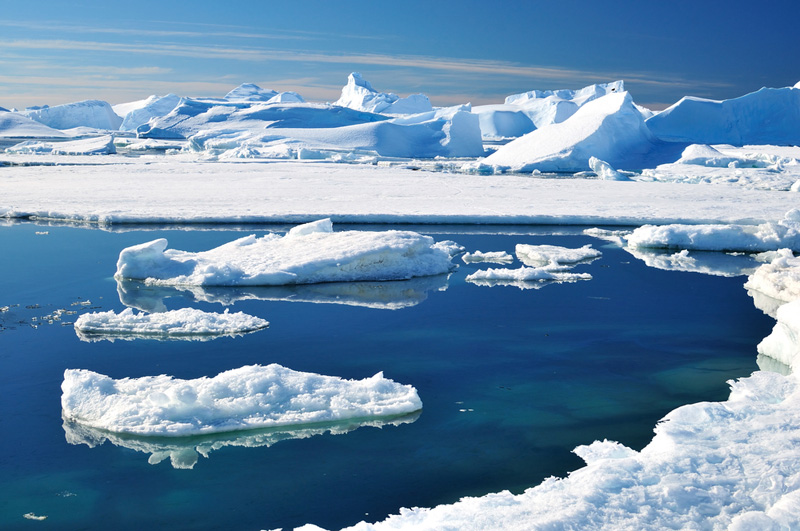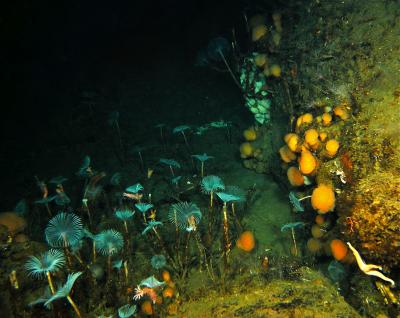As Antarctic Sea Ice Melts, Seaweed Smothers Seafloor

Seaweed could smother polar underwater ecosystems as melting sea ice exposes the seafloor to more sunlight, new research shows.
Animals that dwell on the seafloor of the Arctic and Antarctic spend most of their lives in total darkness: Sea ice blocks rays during the spring and early summer, and the sun sets completely in the winter. Late summer and early fall — when the ocean warms up enough to thaw the ice — often marks the only time these critters see light.
But as climate change causes sea ice to begin melting earlier and earlier in the summer, shallow-water ecosystems will soak up increasingly more rays. New research from a team of Australian biologists suggests this could cause a major shift in the seafloor communities along the coast of Antarctica, where invertebrates like sponges, worms and tunicates — globular organisms that anchor to rocks on the seafloor — currently dominate. A manuscript of the report is currently in press at the journal Global Change Biology. [6 Unexpected Effects of Climate Change]
"Some areas where ice breaks out early in summer are already shifting to algal domination," said Graeme Clark, a biologist at the University of New South Wales who was involved in the study.
Seasons and tipping points
Early-summer ice melt not only lengthens the amount of time photosynthesizing organisms like macroalgae (or seaweed) can thrive under the sun during the summer, but it also increases the intensity of that exposure. The sun sits highest in the sky during the summer solstice — the period when Earth tilts most directly toward the sun — that occurs between June 20 and 23 in the Northern Hemisphere and Dec. 20 and 23 in the Southern Hemisphere, depending on the phase of the Earth's orbit. Rays travel directly to the seafloor during this time. During spring and fall, however, low-angle rays reflect off the sea surface and often never make it to the seafloor.
This compounding effect of a longer sunlit season and higher-intensity rays could exponentially increase the amount of sunlight hitting benthic, or seafloor, communities in the coming decades and cause major tipping points for those invertebrate-dominated ecosystems, Clark said.
Get the world’s most fascinating discoveries delivered straight to your inbox.
Tipping points occur when relatively minor environmental changes — like sea ice melting several days earlier than usual — cause rapid and significant ecological transformation. In this case, the tipping point would push ecosystems from invertebrate-dominated to algae-dominated.
Antarctica algae
To assess how algae might respond to increased sunlight, the team conducted a series of laboratory experiments to determine the light limits for several species of algae. They then surveyed the same species along the coast of East Antarctica to confirm their results in the field, while also collecting several years of sunlight data from light monitors deployed off eastern Antarctica.
The team found that algae routinely encroached on regions with higher levels of sunlight, and calculated that these plantlike organisms could replace up to one-third of seafloor invertebrates in regions that become ice-free during the summer.
Sponges and other invertebrates provide important ecological functions — including filtering seawater and providing surfaces for other species to grow on — so if algae overruns these species, animals throughout the ocean food chain would likely be impacted. [Earth in the Balance: 7 Crucial Tipping Points]
"A lot of fish and other invertebrates use the benthic invertebrate community as habitat and for food, so they are going to be affected," Clark told LiveScience.
Further out to sea, where the seafloor is too deep for sunlight to reach, increased melting may actually benefit seafloor invertebrate communities. One recent study found that sponges proliferated in the years following the collapse of the massive Larsen A Ice Shelf, likely because phytoplankton bloomed in the newly exposed waters, and eventually sank and provided food for the sponges.
But researchers agree that closer to shore, where sunlight bathes the benthos, algae will likely smother such sponges.
"It's probable that the light will increase and the macroalgae will explode," said Laura Fillinger, a researcher in Germany involved in the recent sponge study concerning the Larsen A collapse. "If they do, they will outcompete the sponges."
Arctic algae
A long-term study in the Arctic Ocean has documented this trend already occurring off the coast of Svalbard, Norway, suggesting that algae could smother pockets of shallow marine ecosystems at both poles, Clark said.
Determining where, exactly, these pockets will occur remains difficult, given substantial variability from year to year and across different regions of the poles. For example, sea ice has expanded around some regions of Antarctica but has begun melting up to five days earlier each summer in other regions, Clark said. [Images of Melt: Earth’s Vanishing Ice]
In their future work, the researchers plan to take a closer look at changing sea-ice cover, and hope to conduct a more detailed survey of algal distribution in relation to these changes. They also plan to more closely explore how algal growth will affect invertebrates.
"These [invertebrates] have taken millions of years to evolve, so we obviously want to retain as much of that biological information as possible," said Clark. "Even if there is no clear immediate benefit, they have intrinsic value."
Follow Laura Poppick on Twitter. Follow LiveScience on Twitter, Facebook and Google+. Original article on LiveScience.




